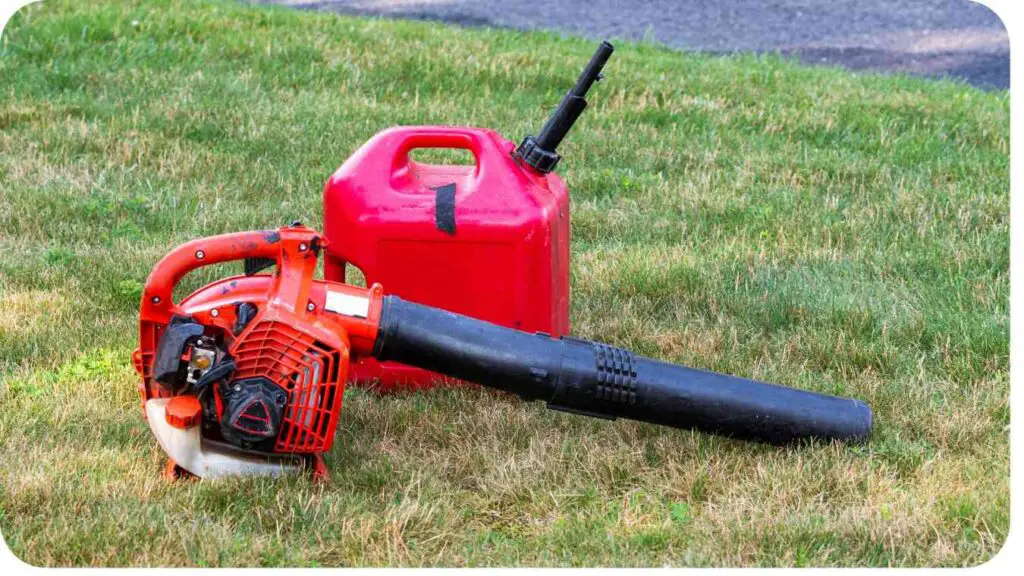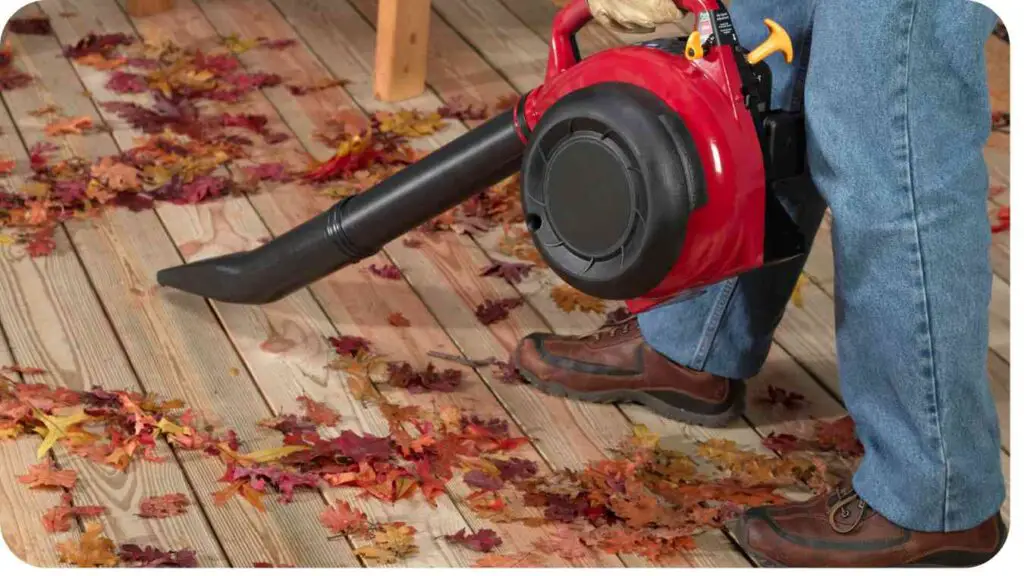Are you experiencing a loss of power with your Husqvarna leaf blower? It can be frustrating when your equipment doesn’t perform as expected, especially when you’re in the midst of tackling yard work.
However, understanding why your leaf blower is losing power is the first step towards finding a solution. In this article, we’ll explore the common causes of power loss and provide practical solutions to get your leaf blower back to optimal performance.
| Key Takeaways |
|---|
| 1. Identify common causes of power loss in leaf blowers. |
| 2. Regularly clean the air intake to prevent airflow restrictions. |
| 3. Check the fuel system for impurities and blockages. |
| 4. Inspect the spark plug annually and replace if necessary. |
| 5. Adjust the carburetor settings for optimal engine performance. |
| 6. Follow preventive maintenance tips to prolong the lifespan of your leaf blower. |
| 7. Use high-quality fuel and follow manufacturer recommendations for fuel mixture. |
| 8. Consult the owner’s manual for specific maintenance instructions and troubleshooting tips. |
| 9. Take proactive steps to address power loss issues to ensure smooth operation of your leaf blower. |
| 10. Consider professional maintenance or repairs if DIY solutions do not resolve the problem. |
2. Understanding the Issue
Before diving into solutions, let’s understand why your Husqvarna leaf blower might be losing power. Leaf blowers are precision tools designed to efficiently clear debris, leaves, and grass from your yard.
However, various factors can contribute to a decrease in performance over time. These factors include clogged air intakes, fuel system issues, spark plug problems, and carburetor adjustments.
To diagnose and address the issue effectively, we need to examine each potential cause and implement appropriate solutions. Let’s delve into each aspect in detail.
Extend the longevity of your garden equipment by properly maintaining your Bosch Garden Battery. Learn how to maximize performance and ensure your tools operate efficiently throughout their lifespan.
3. Common Causes of Power Loss
When your Husqvarna leaf blower starts to lose power, several culprits could be to blame. Let’s explore the common causes:
| Cause | Description |
|---|---|
| Clogged Air Intake | Accumulation of debris and dirt in the air intake can restrict airflow, leading to power loss. |
| Fuel System Issues | Contaminated fuel, improper fuel mixture, or fuel line blockages can affect engine performance. |
| Spark Plug Problems | A faulty or worn-out spark plug can cause misfiring, resulting in power loss. |
| Carburetor Adjustments | Incorrect carburetor settings can affect fuel-air mixture, impacting engine power. |
Identifying the specific cause of power loss will help in implementing targeted solutions.
Cleaning the Air Intake
A clogged air intake is a common issue that can significantly reduce the performance of your leaf blower. Dust, dirt, and debris can accumulate around the air intake, obstructing airflow and causing the engine to struggle. Regularly cleaning the air intake is essential to maintain optimal performance.
To clean the air intake:
- Stop the Leaf Blower: Turn off the leaf blower and allow it to cool down before proceeding.
- Inspect the Air Intake: Locate the air intake on your leaf blower. It’s typically located near the engine.
- Remove Debris: Use a brush or compressed air to remove any debris or buildup around the air intake.
- Check Regularly: Make it a habit to check and clean the air intake before each use to prevent power loss.
Having trouble with your smart garden hub’s weather data reception? Follow these steps to troubleshoot and resolve issues with your Smart Garden Hub, ensuring accurate monitoring and management of your garden’s conditions.
Checking the Fuel System
Issues with the fuel system can also contribute to power loss in your leaf blower. Contaminated fuel, improper fuel mixture, or fuel line blockages can disrupt the engine’s performance. Conducting regular checks and maintenance of the fuel system is crucial for optimal operation.
To check the fuel system:
- Inspect Fuel Quality: Ensure that you’re using clean, high-quality fuel without any impurities.
- Check Fuel Mixture: Verify that the fuel mixture matches the manufacturer’s recommendations.
- Inspect Fuel Lines: Examine the fuel lines for any signs of blockages or damage. Replace if necessary.
- Clean Fuel Filter: If your leaf blower has a fuel filter, clean or replace it regularly to prevent clogs.
By maintaining a healthy fuel system, you can prevent power loss and prolong the lifespan of your leaf blower.
Inspecting the Spark Plug

The spark plug plays a crucial role in igniting the fuel-air mixture in the engine cylinder. A worn-out or faulty spark plug can cause misfiring, resulting in reduced power output. Regular inspection and maintenance of the spark plug are essential for optimal engine performance.
To inspect the spark plug:
- Remove the Spark Plug: Carefully remove the spark plug using a spark plug socket wrench.
- Examine for Wear: Inspect the spark plug for signs of wear, such as erosion or fouling.
- Check Electrodes: Ensure that the electrodes are clean and properly gapped according to the manufacturer’s specifications.
- Replace if Necessary: If the spark plug shows significant wear or damage, replace it with a new one.
A well-maintained spark plug will ensure reliable ignition and consistent power delivery from your leaf blower.
Keep your garden tools in optimal condition with these troubleshooting tips for fixing frequent jamming issues with your Fiskars Pruner. Discover common causes and effective solutions for uninterrupted gardening.
Adjusting the Carburetor
The carburetor plays a vital role in regulating the fuel-air mixture entering the engine. Incorrect carburetor settings can lead to lean or rich fuel mixtures, affecting engine performance. Adjusting the carburetor to the proper settings will optimize fuel efficiency and power output.
To adjust the carburetor:
- Refer to the Manual: Consult the owner’s manual for specific instructions on carburetor adjustment for your leaf blower model.
- Locate Adjustment Screws: Identify the idle speed and mixture adjustment screws on the carburetor.
- Turn Adjustment Screws: Use a screwdriver to turn the adjustment screws according to the manufacturer’s recommendations.
- Test and Fine-Tune: Start the leaf blower and test the performance. Fine-tune the adjustment screws as needed to achieve optimal power output.
Properly adjusting the carburetor will ensure smooth engine operation and maximum power from your leaf blower.
4. Solutions for Power Loss
Now that we’ve identified the common causes of power loss, let’s explore solutions to address these issues effectively.
Cleaning the Air Intake
Regularly cleaning the air intake is essential to prevent power loss caused by restricted airflow. Follow these steps to clean the air intake of your Husqvarna leaf blower:
| Steps | Description |
|---|---|
| Stop the Leaf Blower | Turn off the leaf blower and allow it to cool down before proceeding. |
| Inspect the Air Intake | Locate the air intake on your leaf blower. It’s typically located near the engine. |
| Remove Debris | Use a brush or compressed air to remove any debris or buildup around the air intake. |
| Check Regularly | Make it a habit to check and clean the air intake before each use to prevent power loss. |
Regular maintenance of the air intake will ensure optimal airflow and engine performance.
Checking the Fuel System
The fuel system plays a crucial role in the operation of your leaf blower. Ensure that your fuel system is clean and properly maintained to prevent power loss. Here’s how to check the fuel system:
Decode error codes and resolve issues with your Sun Joe electric mower using this comprehensive guide to troubleshooting and maintenance. Ensure your mower operates smoothly with tips from Sun Joe Electric Mower Error Codes.
| Steps | Description |
|---|---|
| Inspect Fuel Quality | Ensure that you’re using clean, high-quality fuel without any impurities. |
| Check Fuel Mixture | Verify that the fuel mixture matches the manufacturer’s recommendations. |
| Inspect Fuel Lines | Ex |
| Steps | Description |
|---|---|
| Inspect Fuel Lines | Examine the fuel lines for any signs of blockages or damage. Replace if necessary. |
| Clean Fuel Filter | If your leaf blower has a fuel filter, clean or replace it regularly to prevent clogs. |
Regular maintenance of the fuel system will ensure proper fuel delivery and consistent engine performance.
Inspecting the Spark Plug
A faulty spark plug can hinder the ignition process and lead to power loss in your leaf blower. Follow these steps to inspect and maintain the spark plug:
| Steps | Description |
|---|---|
| Remove the Spark Plug | Carefully remove the spark plug using a spark plug socket wrench. |
| Examine for Wear | Inspect the spark plug for signs of wear, such as erosion or fouling. |
| Check Electrodes | Ensure that the electrodes are clean and properly gapped according to specifications. |
| Replace if Necessary | If the spark plug shows significant wear or damage, replace it with a new one. |
Regular inspection and maintenance of the spark plug will ensure reliable ignition and optimal engine performance.
Adjusting the Carburetor
The carburetor regulates the fuel-air mixture entering the engine, affecting power output. Follow these steps to adjust the carburetor for optimal performance:
| Steps | Description |
|---|---|
| Refer to the Manual | Consult the owner’s manual for specific instructions on carburetor adjustment. |
| Locate Adjustment Screws | Identify the idle speed and mixture adjustment screws on the carburetor. |
| Turn Adjustment Screws | Use a screwdriver to turn the adjustment screws according to manufacturer’s recommendations. |
| Test and Fine-Tune | Start the leaf blower and test the performance. Fine-tune the adjustment screws as needed. |
Properly adjusting the carburetor will ensure smooth engine operation and maximum power output from your leaf blower.
Discover solutions to common problems with your Troy-Bilt tiller, including issues with digging functionality. Follow these tips and fixes to troubleshoot and resolve issues with your Troy-Bilt Tiller, ensuring efficient garden maintenance.
5. Preventive Maintenance Tips

In addition to addressing specific issues, regular preventive maintenance is essential to keep your Husqvarna leaf blower in top condition. Here are some tips to maintain optimal performance:
| Maintenance Task | Frequency | Description |
|---|---|---|
| Air Filter Cleaning | After each use | Clean or replace the air filter regularly to prevent debris from entering the engine. |
| Fuel System Check | Monthly | Inspect fuel lines, fuel filter, and fuel quality to ensure proper fuel delivery. |
| Spark Plug Inspection | Annually | Check the condition of the spark plug and replace if necessary. |
| Carburetor Adjustment | As needed | Periodically adjust the carburetor settings for optimal engine performance. |
By following these preventive maintenance tips, you can prolong the lifespan of your leaf blower and avoid potential power loss issues.
6. Conclusion
Experiencing power loss with your Husqvarna leaf blower can be frustrating, but with proper diagnosis and maintenance, you can restore its performance. By understanding the common causes of power loss and implementing targeted solutions such as cleaning the air intake, checking the fuel system, inspecting the spark plug, and adjusting the carburetor, you can keep your leaf blower running smoothly.
Remember to also follow preventive maintenance tips to ensure long-term reliability and optimal performance from your leaf blower. With regular care and attention, your Husqvarna leaf blower will continue to tackle yard work with ease.
If you found this article helpful, be sure to check out our related articles for more tips and advice on maintaining your outdoor power equipment.
Further Reading
- About Husqvarna Leaf Blowers: Learn more about Husqvarna leaf blowers and their features.
- Husqvarna Self-Service: Why Does a Leaf Blower Lose Power While in Use?: Explore the reasons behind power loss in leaf blowers and how to address them.
- Husqvarna 125B Leaf Blower Not Running Correctly: Join the discussion on troubleshooting issues with the Husqvarna 125B leaf blower.
FAQs
Why is my Husqvarna leaf blower losing power?
Power loss in leaf blowers can be caused by various factors such as a clogged air intake, fuel system issues, spark plug problems, or carburetor adjustments.
How do I clean the air intake of my leaf blower?
To clean the air intake, stop the leaf blower, locate the air intake, remove any debris, and ensure it’s clear before each use.
What should I check in the fuel system of my leaf blower?
Inspect the fuel quality, check the fuel mixture, examine fuel lines for blockages or damage, and clean or replace the fuel filter regularly.
How often should I inspect the spark plug of my leaf blower?
It’s recommended to inspect the spark plug annually and replace it if there are signs of wear or damage to ensure reliable ignition.
Can adjusting the carburetor improve the performance of my leaf blower?
Yes, adjusting the carburetor to the proper settings can optimize fuel efficiency and power output, improving the overall performance of the leaf blower.

For 15 years, Hellen James has worked in the gardening industry as an expert and landscape designer. During her career, she has worked for a variety of businesses that specialize in landscaping and gardening from small firms to large corporations.

